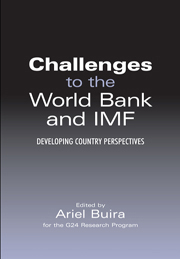Book contents
- Frontmatter
- Contents
- Contributors to this volume
- Foreword
- Introduction
- 1 The Governance of the IMF in a Global Economy
- 2 Who pays for the IMF?
- 3 An Analysis of IMF Conditionality
- 4 Achieving Long-Term Debt Sustainability in Heavily Indebted Poor Countries (HIPCs)
- 5 The Poverty Reduction Strategy Paper Approach: Good Marketing or Good Policy?
- 6 Capital Management Techniques in Developing Countries
- 7 International Reserves to Short-Term External Debt as an Indicator of External Vulnerability: The Experience of Mexico and Other Emerging Economies
- 8 Mechanisms for Dialogue and Debt-Crisis Workout that Can Strengthen Sovereign Lending to Developing Countries
- 9 Developing a Global Partnership for Development
- 10 International Financial Institutions and International Public Goods: Operational Implications for the World Bank
- Index
4 - Achieving Long-Term Debt Sustainability in Heavily Indebted Poor Countries (HIPCs)
- Frontmatter
- Contents
- Contributors to this volume
- Foreword
- Introduction
- 1 The Governance of the IMF in a Global Economy
- 2 Who pays for the IMF?
- 3 An Analysis of IMF Conditionality
- 4 Achieving Long-Term Debt Sustainability in Heavily Indebted Poor Countries (HIPCs)
- 5 The Poverty Reduction Strategy Paper Approach: Good Marketing or Good Policy?
- 6 Capital Management Techniques in Developing Countries
- 7 International Reserves to Short-Term External Debt as an Indicator of External Vulnerability: The Experience of Mexico and Other Emerging Economies
- 8 Mechanisms for Dialogue and Debt-Crisis Workout that Can Strengthen Sovereign Lending to Developing Countries
- 9 Developing a Global Partnership for Development
- 10 International Financial Institutions and International Public Goods: Operational Implications for the World Bank
- Index
Summary
Abstract
This chapter builds on the emerging consensus in the development literature that the enhanced HIPC Initiative does not fully remove the debt overhang in many poor and highly indebted countries. It examines the six most crucial problems of the enhanced HIPC initiative: the use of inappropriate eligibility and debt sustainability criteria; the use of overly optimistic growth assumptions; insufficient provision of interim debt relief; the delivery of some HIPC debt relief through debt rescheduling; non-participation and financing shortfalls of creditors; and the use of currency-specific short-term discount rates to calculate the net present value (NPV) of outstanding debt. To address these shortcomings, the chapter suggests: revising the HIPC eligibility and debt sustainability indicators; using lower bounds of growth assumptions; providing deeper and broader interim debt relief; delivering HIPC debt relief only through debt cancellation; adjusting the current equal burden-sharing concept by releasing the HIPC Trust Fund resources immediately to finance-constrained small regional MDBs; exempting minor creditors from the provision of HIPC debt relief; and using a single fixed low discount rate for all NPV calculations. However, even with these changes, the long-term debt sustainability of HIPCs would remain fragile. The chapter argues that more aid coordination is urgently needed for HIPCs that have not yet reached their decision points; that it makes sense to substitute some loans with grants; that HIPC debt relief has thus far been neither frontloaded nor additional and that 100 per cent debt relief would be feasible as well as desirable for the poorest debtors, irrespective of what their debt levels are.
- Type
- Chapter
- Information
- Challenges to the World Bank and IMFDeveloping Country Perspectives, pp. 91 - 118Publisher: Anthem PressPrint publication year: 2003
- 2
- Cited by

